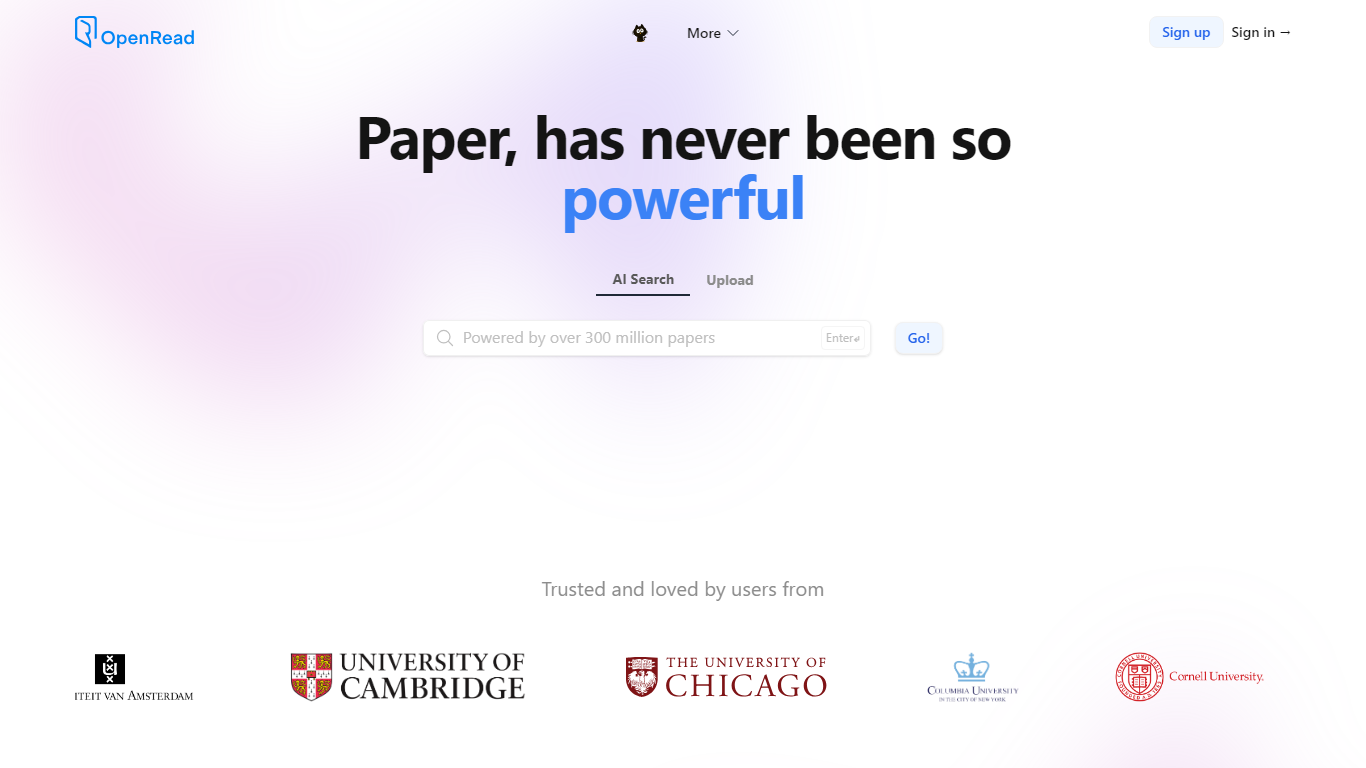TextLayer vs OpenRead
In the face-off between TextLayer vs OpenRead, which AI Research tool takes the crown? We scrutinize features, alternatives, upvotes, reviews, pricing, and more.
In a face-off between TextLayer and OpenRead, which one takes the crown?
If we were to analyze TextLayer and OpenRead, both of which are AI-powered research tools, what would we find? The upvote count favors OpenRead, making it the clear winner. OpenRead has received 8 upvotes from aitools.fyi users, while TextLayer has received 6 upvotes.
Disagree with the result? Upvote your favorite tool and help it win!
TextLayer

What is TextLayer?
Immerse yourself in the frontier of Artificial Intelligence with TextLayer, the go-to platform for AI and data science professionals. TextLayer equips you with the power of GPT-4 and immediate access to ArXiv—the hub for cutting-edge machine learning research. This web-based platform revolutionizes how research is conducted, transforming the latest AI insights into viable, robust solutions.
At TextLayer, innovation is accelerated. The platform provides tailored recommendations, AI-generated insights, and exhaustive implementation guidance to power up your data science projects. Users can benefit from the platform's ability to simplify complex research papers into concise, easy-to-understand summaries, complete with responsive Q&A sessions for in-depth exploration.
TextLayer's trusted environment caters to your specific research needs. Whether you're at the start of your AI journey or a seasoned researcher seeking advanced tools, TextLayer's flexible pricing plans provide the freedom to choose the level of support you need. From the free Explorer plan offering GPT-4 generated summaries to the Trailblazer subscription with unlimited interaction capabilities, TextLayer is also a pioneer in keeping its users at the vanguard of AI innovation.
OpenRead

What is OpenRead?
OpenRead is an advanced academic platform committed to enhancing the research experience by removing traditional barriers to knowledge access. Trusted by a dedicated user base, OpenRead utilizes AI-driven search capabilities to aid researchers and students alike in their quest for academic material.
Using the power of semantic search, OpenRead allows users to input natural language queries to swiftly find and match over 300 million papers with the meaning behind their questions. The AI Summary feature further revolutionizes learning efficiency by condensing search results into succinct paragraphs, saving users up to 70% of the time typically spent on new concepts.
The platform's extensive database spans more than 400 categories across over a thousand journals, offering a breadth of knowledge in numerous disciplines. With innovative tools like Paper Espresso and Paper Q&A, users can quickly gauge a paper's relevance and delve into specific content with ease, while the Related Paper Graph feature visually maps the connections between research documents.
OpenRead emphasizes a seamless integration of reading and note-taking, enabling users to consolidate their insights alongside corresponding papers. This functionality fosters a cohesive research experience and the construction of a personal knowledge bank within a single ecosystem.
As part of its commitment to knowledge accessibility, OpenRead invites researchers and institutions to join its university alliance, aspiring to remove paywalls and ease the exchange between academic notes and writing tools.
TextLayer Upvotes
OpenRead Upvotes
TextLayer Top Features
Simplified Access: Utilize a search portal to easily discover the latest in ML research.
Personalized Recommendations: Receive AI-curated research suggestions that align with your interests.
Responsive Q&A Sessions: Engage with GPT-4 for a deeper understanding of ML concepts.
Implementation Support: Get step-by-step guidance from GPT-4 to apply AI research effectively.
Flexible Pricing: Choose from various subscription plans tailored to your research journey.
OpenRead Top Features
Semantic Search: Utilize natural language queries for swift and accurate paper matching.
AI Summary: Receive concise summaries to accelerate learning and concept acquisition.
Paper Espresso: Quickly understand a paper's key points and relevance to your research.
Paper Q&A: Engage in a deep guided exploration within a specific paper to enhance understanding.
Notes Taking: Seamlessly integrate and organize your research notes in one central location.
TextLayer Category
- Research
OpenRead Category
- Research
TextLayer Pricing Type
- Freemium
OpenRead Pricing Type
- Freemium
